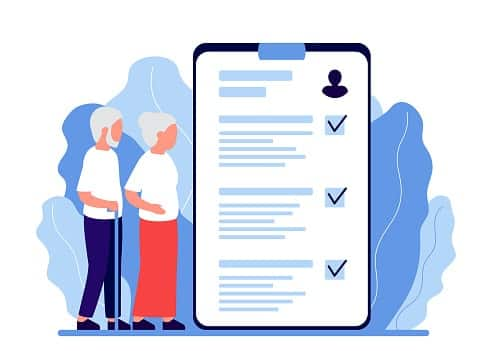- Types of Indiana health insurance
- Best health insurance in Indiana
- Indiana has no individual mandate or penalty
- Health insurance subsidies in Indiana
- How much is health insurance in Indiana?
- How to buy health insurance in Indiana
- COBRA insurance in Indiana
- Other ways to get health insurance in Indiana
- Sources
Types of Indiana health insurance
Indiana doesn't operate its own healthcare marketplace exchange. Instead, it relies on the federal marketplace exchange at Healthcare.gov.
Indiana residents can select from four different health insurance tiers based on costs:
- Bronze: Lowest premiums but highest out-of-pocket costs; plans pay 60% of your medical expenses.
- Silver: Low premiums and higher out-of-pocket costs than Platinum or Gold; plans pay 70% of your medical expenses.
- Gold: Low out-of-pocket costs but high premiums; plans pay 80% of your medical expenses.
- Platinum: Lowest out-of-pocket costs, but highest premiums; plans pay 90% of your medical expenses.
Choosing the metal tier that's best for you depends on several criteria, such as your financial state, health status, coverage goals and how often you plan to use your insurance.
When you may want to consider a Bronze plan:
- You’re young and healthy and don't expect to require many health care services.
- You wish to pay the lowest premiums possible.
When you may want to opt for a Silver plan:
- You need cheaper premiums but want to avoid high out-of-pocket expenses.
- Your household is eligible for additional subsidies found in Silver plans.
When you may want a Gold plan:
- You don't mind paying higher premiums in exchange for spending less when you need health care services.
- You anticipate needing several health care services over the next plan year.
When you may prefer a Platinum plan:
- You want to pay the lowest out-of-pocket costs when you need health care services but don't mind paying the highest premiums.
- You expect to visit a physician often, need multiple prescription medications and utilize several health care services.
Best health insurance in Indiana
In 2024, there are six insurers offering plans in Indiana on the federal healthcare exchange:
- Aetna – Available in 18 counties
- Anthem – Available in 87 counties
- CareSource – Offers plans statewide
- Celtic – Offers plans statewide
- Cigna – Available in 8 counties
- US Health and Life – Available in 8 counties
Choosing which insurance company and plan is right for you depends on your healthcare needs. To make a more informed decision, it helps to ask yourself important questions, such as:
- Do I want to pay lower premiums or lower out-of-pocket costs when I need care?
- Are my preferred doctors and providers participating in the plan's network?
- Does the plan cover my prescription medications?
- Is a referral required to see a specialist?
There are three different plan types on the federal exchange available to Hoosiers (PPOs are not an option):
- Health maintenance organization (HMO) plans: These plans are less expensive than EPOs, but more restrictive. You will likely be required to choose a primary care physician and obtain referrals from that provider if you want to see a specialist in the network. Also, HMOs commonly don't cover costs for out-of-network care unless it's an emergency.
- Exclusive provider organization (EPO) plans: EPOs function as a hybrid of HMOs and PPOs. As with an HMO, you have to remain within your plan's network. However, you don't have to select a primary care physician or obtain referrals for visits to a specialist.
- Point of service (POS) plans: You pay less if you use physicians, hospitals and other healthcare providers within the plan's network. However, POS plans obligate you to obtain a referral from your primary care physician if you want to see a specialist.
Find out more about the differences in the health plan types.
If you need dental coverage, you can also opt for dental insurance through the federal marketplace. But you need to sign up for an ACA health care plan to be eligible for a dental plan available on the federal exchange.
After enrolling in a health care plan at Healthcare.gov, you can shop for available dental plans on the same website.
Indiana has no individual mandate or penalty
When it was first put into law, the ACA had an individual mandate that required most Americans to have health care insurance or pay a fee at tax time. Congress has eliminated the individual mandate penalty on the federal level.
Some states now require health insurance, but Hoosiers don’t need health coverage. Even though you aren't required to get health insurance, having coverage is a smart strategy that can save you hundreds of thousands of dollars in the long run. It can be astronomically expensive to pay for a hospital stay, surgery, emergency care, doctor visits, prescription drugs and other healthcare-related costs completely out-of-pocket.
Health insurance subsidies in Indiana
Americans benefit from cost-saving subsidies in the ACA exchanges based on their household income. These subsidies help cover premium costs and decrease out-of-pocket costs.
In Indiana, adults with household incomes of approximately 138% of the federal poverty level (FPL) or less can apply for Medicaid or other health care coverage through the state of Indiana. Indiana adults with household incomes above 138% of the FPL qualify for subsidized coverage at Healthcare.gov.
Indiana Households beneath subsidy eligibility may qualify for the state's Medicaid program, Healthy Indiana Plan (HIP), which offers low-cost healthcare coverage to families and individuals who are eligible based on household income.
| Household size | Eligible for Indiana's health coverage programs |
|---|---|
| 1 | $20,793.00 or less |
| 2 | $28,214.40 or less |
| 3 | $35,635.20 or less |
| 4 | $43,056.00 or less |
| 5 | $50,489.40 or less |
| 6 | $57,910.20 or less |
| 7 | $65,331.00 or less |
| 8 | $72,764.40 or less |
Source: State of Indiana
How much is health insurance in Indiana?
The costs for healthcare in Indiana depends based on several factors, including premiums, deductibles, out-of-pocket costs, where you live and how you receive coverage.
Below are the differences in average lowest premium costs in 2024 for three of the metal tiers offered:
- Bronze: $335
- Silver: $394
- Gold: $517
Source: Kaiser Family Foundation
Estimates for Platinum plans, which only represent a small portion of ACA plans, were not provided by the Kaiser Family Foundation.
Be aware that these average costs don't take into account applicable subsidies. If you’re eligible for subsidies, it's likely that you'll pay much less than these average premium costs.
How to buy health insurance in Indiana
In Indiana, you can get a healthcare plan through the federal marketplace at Healthcare.gov during open enrollment, which runs from Nov. 1 to Jan. 15 each year.
More than 2.3 million Indiana residents enrolled in an ACA plan through the federal exchange in 2023.
You can sign up for an ACA plan through the federal exchange at other times of the year if you qualify for a special enrollment period because you:
- Lost your job
- Lost your health insurance
- Moved
- Turned 26 and aren’t eligible to remain on a parent's plan
- Got married or entered into a domestic partnership
- Became the parent of a newborn
- Were impacted by wildfires
- Became a U.S. citizen
- Experienced a change in household size
- Returned from active military service
- Were released from jail or prison
If you qualify, you will have 60 days to enroll or make changes to your healthcare plan. To enroll, visit Healthcare.gov, phone 800-318-2596 or apply with a certified enroller or broker. Be sure to collect the following documents first:
- Social Security numbers or immigration documents
- Federal tax information (if you file)
- Employer and income information for your household
COBRA insurance in Indiana
If you lose your job from a company that provided employer-sponsored group health insurance, you may qualify for enrollment in a COBRA plan. This option enables you to continue your coverage for a limited period – usually between 18 and 36 months.
However, COBRA comes with caveats. Namely, you’re responsible for all the costs – including premiums, copays, deductibles and prescription drugs. Your former employer will not contribute funds to help offset these costs. Additionally, this coverage is offered when the business had 20 or more employees.
Unlike most states, Indiana doesn’t have a mini-COBRA law to help former employees of businesses with fewer than 20 employees. Instead, you’ll have to get coverage elsewhere, including the ACA exchange, short-term health insurance or Medicaid if you’re eligible.
Health insurance finder tool

COBRA
Learn more about COBRA
How much is your annual household income?
How many members are in your household?
Medicare
Medicare costs vary depending on which option you choose.
Learn more about Medicare costs.
Medicaid

Parent's employer-sponsored health insurance

Spouse's employer-sponsored health insurance

Employer-sponsored health insurance

Preferred-provider Organization (PPOs)
Preferred-provider organization (PPOs) plans are the most common type of
employer-based health plan. PPOs have higher premiums than HMOs and HDHPs, but
those added costs offer you flexibility. A PPO allows you to get care anywhere
and without primary care provider referrals. You may have to pay more to get
out-of-network care, but a PPO will pick up a portion of the costs.
Find out more about the differences between plansHealth maintenance organization (HMO)
Health maintenance organization (HMO) plans have lower premiums than PPOs.
However, HMOs have more restrictions. HMOs don't allow you to get care outside
of your provider network. If you get out-of-network care, you'll likely have to
pay for all of it. HMOs also require you to get primary care provider referrals
to see specialists.
Find out more about the differences between plansHigh-deductible health plans (HDHPs)
High-deductible health plans (HDHPs) have become more common as employers look
to reduce their health costs. HDHPs have lower premiums than PPOs and HMOs, but
much higher deductibles. A deductible is what you have to pay for health care
services before your health plan chips in money. Once you reach your deductible,
the health plan pays a portion and you pay your share, which is called
coinsurance.
Find out more about the differences between plansExclusive provider organization (EPO)
Exclusive provider organization (EPO) plans offer the flexibility of a PPO with
the restricted network found in an HMO. EPOs don't require that members get a
referral to see a specialist. In that way, it's similar to a PPO. However, an
EPO requires in-network care, which is like an HMO.
Find out more about the differences between plans
Learn more about individual insurance plans
Other ways to get health insurance in Indiana
Obamacare, Medicare, Medicaid, Healthy Indiana Plan coverage and employer-sponsored group plans aren't your only options for health care coverage in Indiana. You can also get:
- An individual private plan outside of the Healthcare.gov exchange
- A catastrophic health plan
- A short-term health plan
Individual private plans purchased directly from a health insurer may provide alternative choices. However, these plans don't qualify for subsidies. That's why, if you’re eligible for subsidies, it's best to shop around for a plan offered at Healthcare.gov.
Catastrophic plans are available to applicants younger than 30 or those who qualify for a hardship exemption. Catastrophic plans offer many benefits similar to what's included in a conventional health care plan. The downside is that they come with much costlier out-of-pocket expenses. If you qualify, you can enroll in a catastrophic plan directly with an insurer. Before you do, however, note that a Bronze plan might be a better option, because:
- You may qualify for subsidies with a Bronze plan.
- Premiums are similar for Bronze plans and catastrophic plans.
- Deductibles may be lower with a Bronze plan.
You could also consider a short-term health plan. These plans have low premiums but come with higher out-of-pocket costs. Also, they don't often cover health care services like maternity care, mental health and prescription medications, services that ACA plans are required to cover. In Indiana, short-term plans can have initial terms up to 364 days and are renewable for up to three years.
Use Insurance.com's Health Plan Finder tool to investigate your health insurance eligibility.
Sources
- Indiana Family and Social Services Administration. “Indiana 2024 ACA Filings.” Accessed April 2024.
- Indiana Family and Social Services Administration. “Adult Income Chart.” Accessed April 2024.
- KFF. “Average Marketplace Premiums by Metal Tier, 2018-2024.” Accessed April 2024.
- Indiana Capital Chronicle. “ACA enrollment grows as Indiana unwinds Medicaid coverage.” Accessed April 2024.












